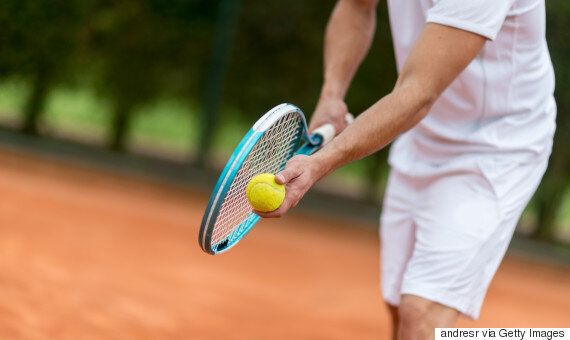That aching pain in your elbow -- the one you feel when you swing a racquet, hammer, mixing spoon or paintbrush -- chances are it's lateral epicondylitis, also known as tennis elbow. Unfortunately, there's no quick fix for the condition but with a little time and the right treatment you won't have to put your racquet away forever.

What Causes Tennis Elbow?
Tennis elbow is caused by inflammation in the tendons that attach forearm muscles to the three bones that make up your elbow: the humerus in the upper arm and the radius and ulna in the forearm. The bumps you feel on the outside of your elbow joint (where the humerus meets the other bones) is called the lateral epicondyles. The muscles, tendons and ligaments that hold the elbow together can be easily overused during a range of recreational and occupational activities.
The National Institutes of Health explains the condition well: "When you use these muscles over and over again, small tears develop in the tendon. Over time, this leads to irritation and pain where the tendon is attached to the bone."
Joseph Brence, a physical therapist, educator and researcher from Pittsburgh, PA treats lots of older patients with tennis elbow. "Despite its name, fewer than 5% of tennis elbow cases occur in people who actually play tennis," he says. "Pain is often caused by other repetitive activities of the elbow, wrist and hand. While the condition commonly affects people ages 30-50, we're seeing it affect a growing number of active older adults who perform repetitive activities with their hands, wrists and arms."
What Does Tennis Elbow Feel Like?
Tennis elbow hurts and pain can come on suddenly. I actually developed a mild case of tennis elbow when my kitchen mixer broke down during my annual gingerbread bake-fest. A neighbor got tennis elbow while painting his kitchen. While we both felt pain on the outside of the elbow, we ignored it equally and powered through.
In my case, overzealous mixing caused the pain in my elbow to stick around for several days. Eventually, I treated it with ice packs, ibuprofen and immobilization, and pretty soon my elbow was fully recovered. Unfortunately, my neighbor wasn't so lucky. After a week of treating the pain with ice and anti-inflammatory medication, his elbow still hurt. Lifting his coffee cup and opening his front door were painful. He knew it was time to see his physician.
How is Tennis Elbow Diagnosed?
A doctor will diagnose the condition by doing a physical exam and asking about the activities that precluded your pain. You may have to fully extend your arm and straighten your wrist and fingers while gentle resistance is applied to the affected area. If your arm hurts, your doctor will know that the muscles and tendons attached to your elbow are irritated or injured. An x-ray, MRI or other diagnostic imaging test may be required to rule out arthritis, a bone fracture or other diseases.
How to Fix Tennis Elbow
The American Academy of Orthopedic Surgeons reports that approximately 80 to 95% of patients have success with nonsurgical treatment. If your pain is severe, a doctor may prescribe stronger pain management medication and recommend you see a physical therapist.
Dr. Tobi Greene is the founder of Ryical Medical Consulting in New York and a board-certified physician who works with older patients. "Tennis elbow is a degenerative process," he says. "It usually resolves on its own but it may last several months or even a few years if it's not treated. I recommend patients rest the elbow, try ice and over-the-counter pain medications like ibuprofen, and then, if it doesn't resolve, make an appointment with an orthopedic surgeon who specializes in elbow joints or upper extremities."
Four Remedies for Tennis Elbow
If ice, rest and ibuprofen don't work, here are four alternative remedies for treating tennis elbow:
1. Physical Therapy
Physical therapy can be highly successful for improving comfort and range of motion in older adults who suffer from tennis elbow or tendonitis. Once the initial injury is on the mend, treatment may include specific exercises to stretch and strengthen the muscles that help the elbow move. Treatment might also include soft tissue therapies such as massage and active tissue release or electrotherapies that use ultrasound or lasers and acupuncture.
As Brence says, "Tennis elbow can be easily managed with the help of a physical therapist; they can create an individual treatment plan for you and help reduce your symptoms."
2. Cortisone Injections
In the short term, your physician may prescribe cortisone injections to reduce inflammation and pain. They may also recommend you use an elbow brace or tennis elbow strap.
3. Surgery
If your symptoms don't improve in six to 12 months, surgery followed by a period of rehabilitation might be your best option. According to the American Academy of Orthopedic Surgeons, most surgical procedures for tennis elbow involve removing diseased muscle and reattaching healthy muscle back to bone. Surgery, the Academy reports, is successful for 80 to 90% of patients with most surgical patients back to their usual activities within four to six months.
4. Platelet-Rich Plasma
The Academy also reports that a new procedure to remedy tennis elbow is on the horizon, one that's showing a lot of promise. Many famous athletes -- Tiger Woods, tennis star Rafael Nadal, and several others -- have received platelet-rich plasma for various problems, such as sprained knees and chronic tendon injuries.
Jeanne Faulkner is an RN with 25 years' experience working in women's health. Based in Portland, OR, she's the author of Common Sense Pregnancy and writes about health and wellness for a variety of publications and websites. As a CARE chairperson for advocacy, she's traveled worldwide to raise awareness of poverty eradication and global health issues.
Also on HuffPost Canada:
Follow HuffPost Canada Blogs on Facebook